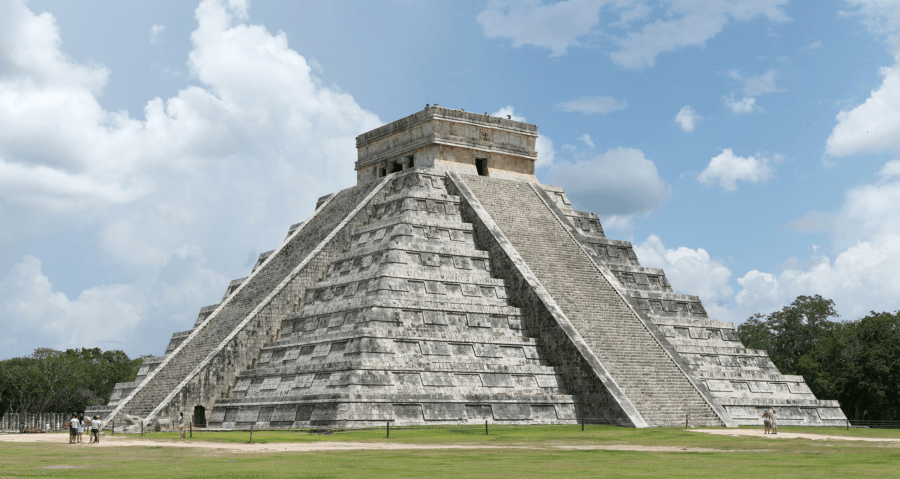The discovery of the 1,000-year-old sculpture came as excavation crews prepared the area for the future placement of a train route through the Yucatán Peninsula.

INAH Yucatán CenterThe statue depicts a Maya warrior with a serpent helmet and feathered headdress.
Archaeologists with Mexico’s National Institute of Anthropology and History (INAH) recently discovered an ancient Maya statue featuring a warrior wearing a serpent helmet.
The statue, measuring 13 inches tall and 11 inches wide, was in very good condition aside from a small crack. It depicted the head of a warrior clad with a feathered headdress and a helmet shaped like a serpent with an open jaw.
“It was customary to represent warriors with a headdress, with a kind of helmet,” said INAH head Diego Prieto Hernández in a statement released by the institute (translated from Spanish using Google Translate). “In this case it is a snake figure from which the face of this character emerges, and a feathered headdress, so it is probably alluding to Kukulcán, the feathered serpent of the Maya.”
The statue was found at Chichén Itzá in the Yucatán Peninsula. Excavations of the Casa Colorada Complex where the statue was unearthed also revealed intricate hieroglyphs dated to the ninth century C.E. The statue may have been part of a larger sculptural design.
Chichén Itzá, meaning “at the mouth of the well of Itza” (referring to the cenote around which the site was built), is a UNESCO World Heritage Site. It rose to prominence during the Late Classic and Terminal Classic periods and had an estimated population of 35,000 people across its four square miles at its peak.

Daniel SchwenChichén Itzá is a historical and cultural site developed by the Maya during the Late Classic and Terminal Classic periods.
Serpent imagery and symbolism were common in Maya culture, representing various concepts, including transformation, fertility, and rebirth. Serpent warriors led religious ceremonies, serving as “intermediaries between the earthly and supernatural realms,” according to Ancient Origins.
Serpent headdresses and the similar jaguar headdresses often associated with Maya culture were created by skilled artisans who passed down their trade through generations, creating unique cultural and historical artifacts.
Archaeologists have been excavating the area ahead of the construction of Mexico’s controversial Maya Train project. The project, a major policy goal of President Andrés Manuel López Obrador, began construction in 2020. It is planned to serve as a railroad across the Yucatán Peninsula, from the tourist hotspots of the beaches of Cancun and Tulum to the archaeological sites in the Maya jungle.
INAH head Hernández said that to date, archaeologists conducting excavations at the sites planned to be used for construction of the Maya Train have recovered “57,146 real estate elements; 1,925 personal property; 1,398,083 ceramic fragments and 1,467 pieces under restoration,” as well as 660 human burials.
President Obrador has been promoting the project since the start of his tenure, claiming it will bring jobs and infrastructure improvements to the country’s poorest regions.

Indigenous and Popular Regional Council XpujilConstruction for the Maya Train is thought to have displaced at least 3,000 households along the route.
However, the Maya Train has been denounced and protested by the Indigenous communities being displaced by the project. According to The Guardian, at least 3,000 households have already been displaced by construction of the $20 billion railway project.
“What is being done with the Maya train megaproject is not Mayan in any way. It is a decision from above,” Q’anjob’al Maya leader Romel González Díaz said at a protest in May 2023.
Indigenous people and advocates have been joined in their protests by scientists and environmentalists who say the project will cause immense environmental damage. A section of the route runs through the Calakmul biosphere reserve, a UNESCO World Heritage Site home to many exotic and endangered species.
“They said it would bring development but it will be just the opposite,” said Sara López González, a member of the Regional Indigenous and Popular Council, in an interview with The Guardian. “It is a megaproject of death. It is an ecocide.”
After reading about the statue found at Chichén Itzá, read about the restoration of El Castillo, the iconic Chichén Itzá temple. Or, check out these vintage photos of historical expeditions in Central and South America.





